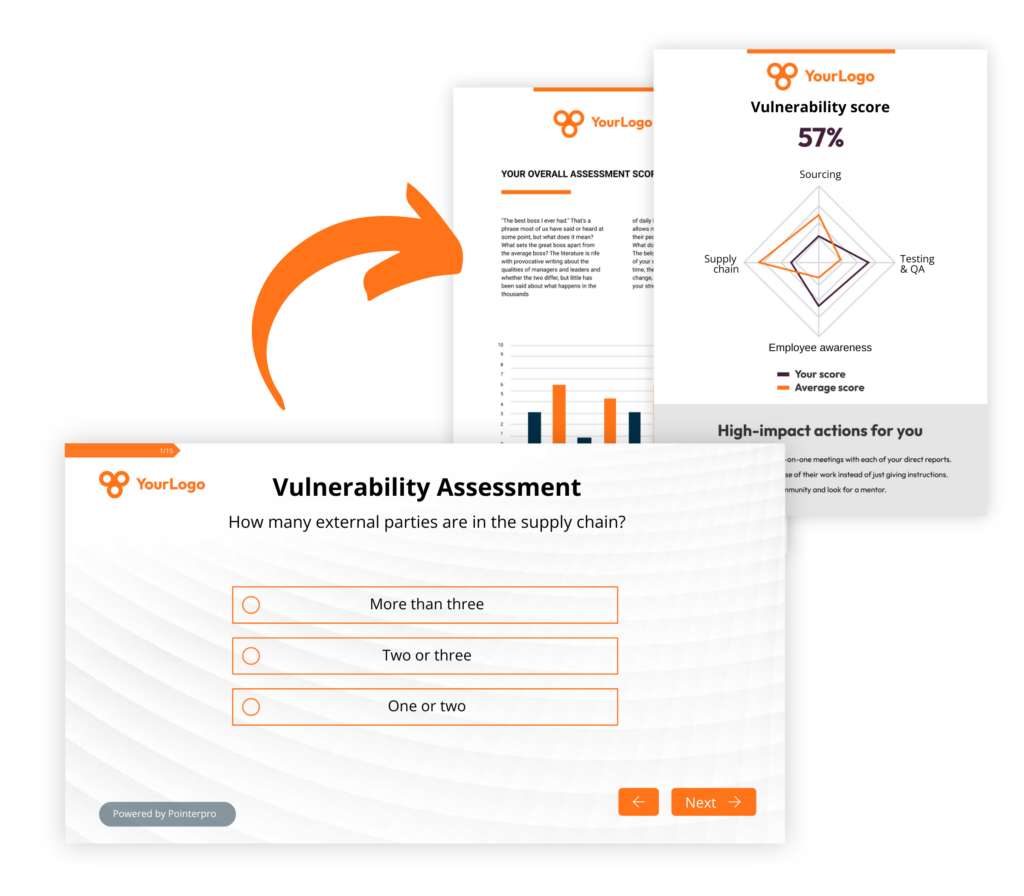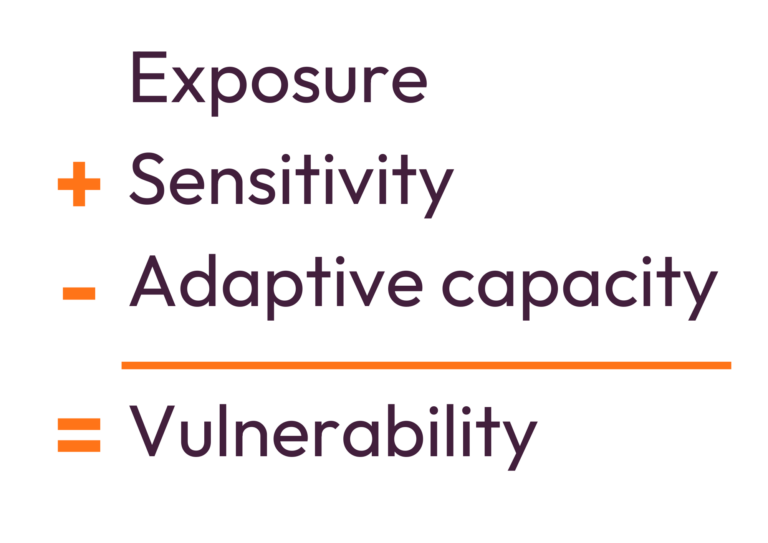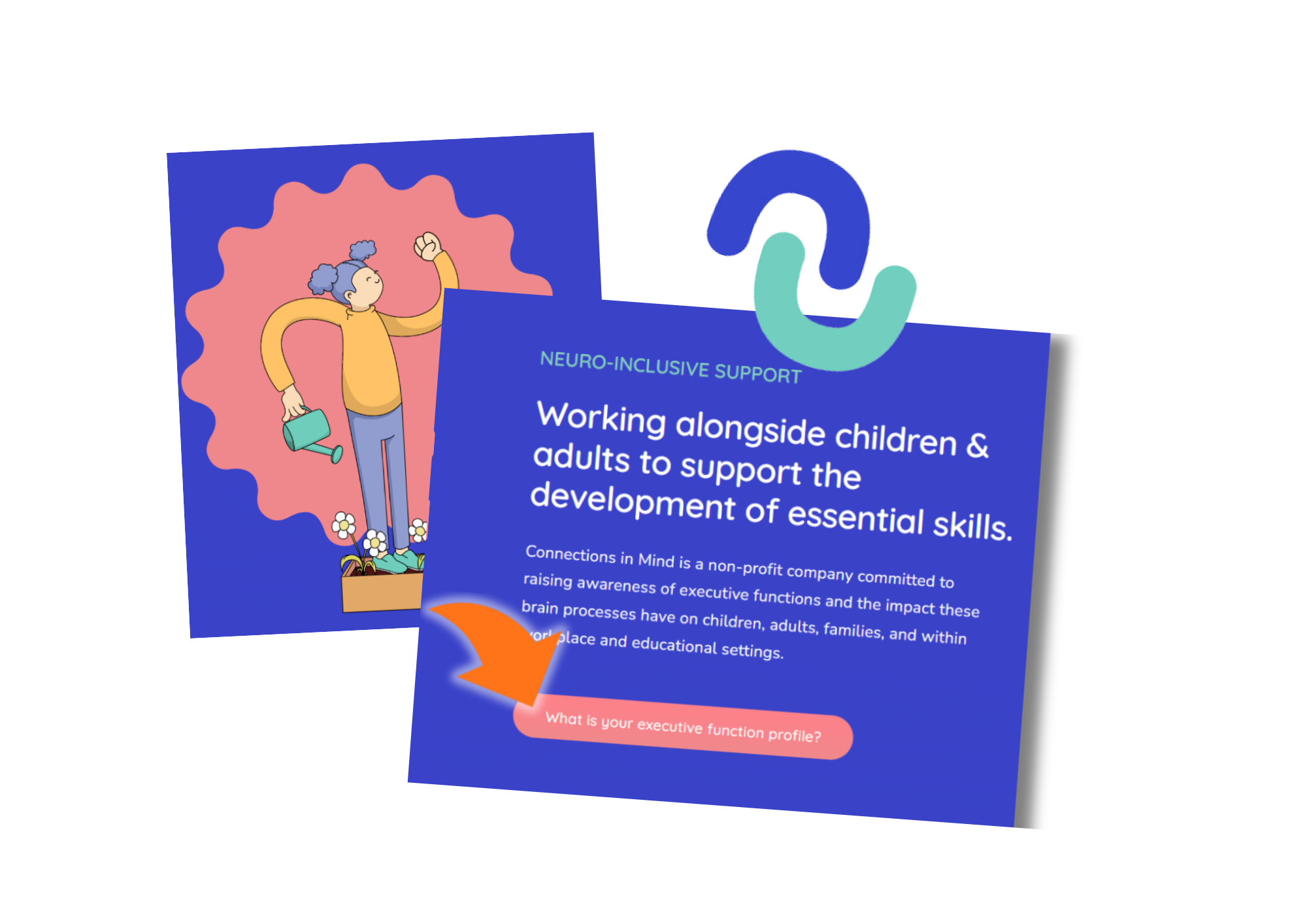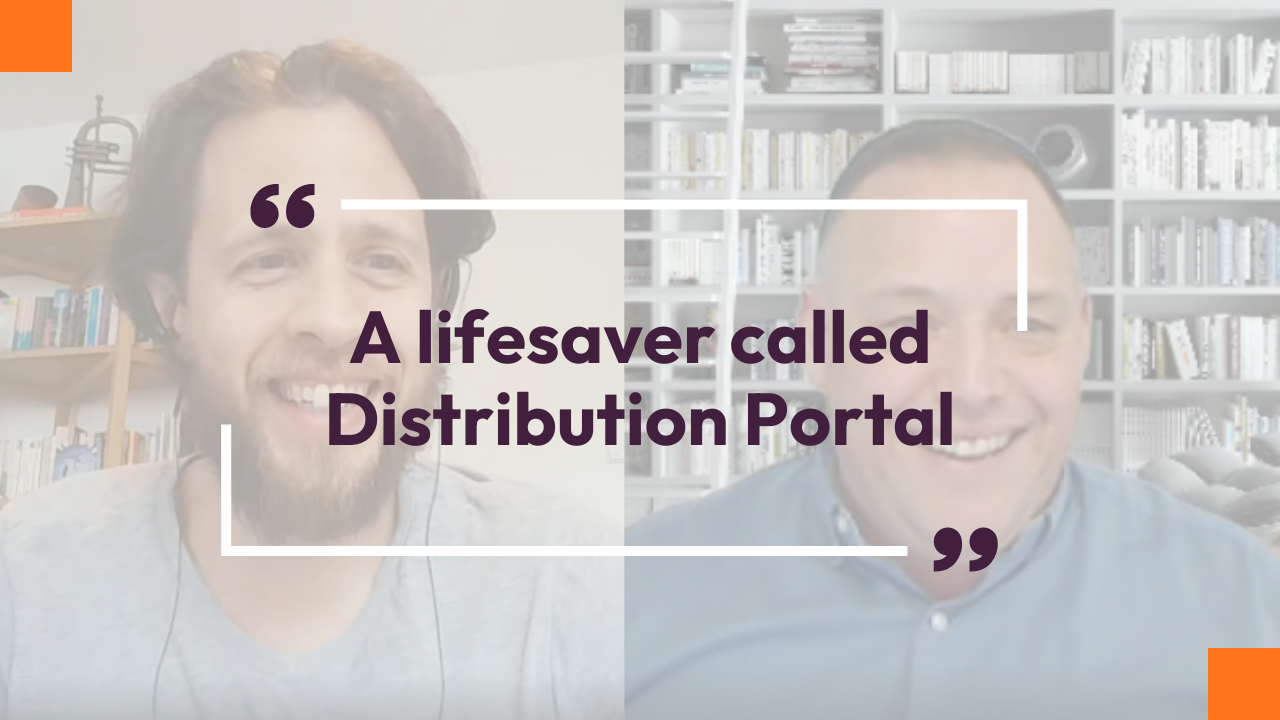Vulnerability assessment template
The devil is in the details. Even – or especially – when a business runs smoothly, some important questions tend to remain unaddressed.
Ask and assess them before they turn into real threats. The key? Advising stakeholders promptly with actionable feedback.
Pointerpro is the 2-in-1 software that combines assessment building with personalized PDF report generation.

How to create a vulnerability assessment template: The essential checklist
Building a comprehensive vulnerability assessment can be overwhelming, especially when you want to ensure all areas of an organization are covered. A well-thought vulnerability assessment template is a crucial tool for identifying, assessing, and prioritizing potential security risks within your organization.
It’s based on a structured framework to evaluate systems, processes, and networks for vulnerabilities that could be exploited by malicious actors.
- Define the scope of your assessment: Outline the specific areas, processes, or systems being evaluated and whether the focus is internal, external, or both. Finding this balance is very important. It would be unwise to combine too many variables. Especially if you’re a consultant, focusing on your specialized expertise will make the true difference for your customer.
- Identify key assets and potential vulnerabilities: Document the critical assets that could be at risk, including resources such as products, systems, technologies, or processes. List the vulnerabilities relevant to your field, considering both historical issues and emerging threats.
- Categorize the vulnerabilities: Classify vulnerabilities by their severity, such as critical, high, medium, or low, based on their potential consequences. But also, make sure you categorize vulnerabilities in terms of the domains they affect. This will clarify reporting and make it easier to take measurable actions for mitigation. For instance, for a work facility, you could have the following four focal points (again, depending on your specialized expertise): Operational processes, physical security, cybersecurity, and energy systems.
- Define the lists of questions and the respondents: Now that you have defined the different categories you’ll analyze with your vulnerability assessment template, think about what questions you need answered to gauge vulnerability in each category. Consider who would be the ideal respondents who’d provide the most accurate answers. Accordingly, you could decide to create a 360 assessment. This simply means you’d split up your vulnerability assessment into several ones. With the right assessment tool you can compile aggregate reports to summarize results and formulate advice.
To actually assess and pour the answers into one or more reports, a few more steps are needed. We’ll discuss them below.
3 reasons to use Pointerpro as a vulnerability assessment tool
3 reasons to use Pointerpro as a vulnerability assessment tool
Interactive user experience
With the Questionnaire Builder you get to create an engaging assessment. How? With numerous design and layout options, useful widgets and countless question types.
Refined, score-based analysis
Our custom scoring engine helps you score different categories or domains of vulnerability. The result? An objective and nuanced vulnerability assessment.
Automated feedback in PDF
Thanks to your setup in the Report Builder, respondents instantly get a detailed PDF report: with helpful charts, a personalized analysis, and actionable tips.
1.500+ businesses worldwide build assessments with Pointerpro









Key dimensions of a vulnerability assessment: The vulnerability formula
As mentioned, it’s more than helpful to categorize areas you evaluate in your vulnerability assessment. Besides the different areas you focus on – based on your own specializations – it’s also very insightful for stakeholders to get a sense of the different dimensions of vulnerability. These dimensions ultimately gauge how likely it is that an organization is negatively affected by the vulnerability. Here are the 3 dimensions:
- Exposure: This refers to how much you come into contact with the risk itself. It’s about your proximity to danger. For example, if you’re evaluating physical security in a workplace environment, exposure to certain machinery will differ depending on the responsibilities and tasks of personnel.
- Sensitivity: How severely does the risk affect someone? For example, even though cybersecurity is something that probably impacts any organization, not all organizations - or not all departments - are affected as much in their work by a cybersecurity breach. Knowledge workers tend to be highly sensitive, while factory workers may be less affected.
- Adaptive capacity: This refers to the ability of actors to handle the risk or recover from it. It’s about how prepared and resilient people or systems are when the vulnerability turns into a impactful threat. For instance, if the supply chain of a company is interrupted due to a specific vulnerability, there may or may not be alternative processes that can be activated to limit or even overcome the impact.

How to gauge different dimensions with your vulnerability assessment template?
So, ultimately, the quality of your vulnerability assessment comes down to how well you’re able to map out the different areas and dimensions of vulnerability.
Of course, not every question you’ll assess will have the same weight. For instance, even though adaptive capability would lower the ultimate vulnerability score – any adaptive strategy tends to be only temporary. Therefore its positive weight on the vulnerability score should not be overestimated. In other words: One adaptive strategy doesn’t cancel out one vulnerability.
This is why it’s important to use an assessment tool that allows you to apply custom scoring. In the video below, Pointerpro’s Product Director explains the principle of custom scoring through a simple, generic example:
The vulnerability assessment report template
So once you’ve defined all your questions, defined the weights and of course collected the answers, it’s time to put together a report.
Well, actually, with a tool like Pointerpro. It’s a matter of putting together a vulnerability assessment report template. Thanks to conditional formulas and the powerful assessment engine you basically compose a report once. Whenever you distribute and conduct the questionnaire or questionnaires to your audience, the reports will auto-generate with personalized advice for the respondents – and/or for other stakeholders.
Here are some key components and tips we think you should consider for your report template, no matter what:
- Executive summary: Provide a brief overview of the assessment, including the purpose, scope, key findings, and main recommendations for quick reference. This is particularly useful for high-level stakeholders who want to stay informed without going into the depths of any reports.
- Detailed findings: Present a thorough breakdown of the vulnerabilities identified, categorized by domain (e.g., physical security, supply chain, or cybersecurity), and assess their impact and likelihood. Try to be as visual as possible, using appropriate charts and graphs.
- Risk prioritization: Include a section in which you highlight which vulnerabilities are most critical based on their severity and potential impact, using a clear ranking or scoring system to guide decision-making.
- Actionable recommendations: Based on the vulnerability profile you’ve identified using your custom scoring system, offer specific, prioritized steps for addressing each identified vulnerability. It’s useful here to include timelines, responsible parties, and suggested resources or tools. If you are a consultant who offers certain services that can be relevant, this is the ideal place to do so in the report.
Tip for consultants: Expressing vulnerability in terms of maturity
If you are a consultant – but even if you’re an in-house specialist – and you want your assessment based advice to be followed, chances are you will have to use a project-based approach. And in order for people to make progress on projects, you need milestones.
In terms of vulnerability mitigation, a milestone could simply be reaching a loer level of vulnerability. To frame this more positively and work toward a positive goal together, you could translate your vulnerability framework into a maturity model. Instead of assessing how “vulnerable” an organization is, you’re basically assessing “how mature an organization is at mitigating vulnerabilities.
In the video below, Pointerpro’s Stacy Demes introduces the concept:
30 vulnerability assessment example questions
Here are 30 of the best vulnerability assessment example questions divided into 3 categories:
- 10 food fraud vulnerability assessment (FFVA) example questions
- 10 facility vulnerability assessment example questions
- 10 personal security vulnerability assessment example questions
10 food fraud vulnerability assessment (FFVA) example questions
A very specific type of vulnarability assessment is the food fraud vulnerability assessment. It’s commonly used by food manufacturers, processors, retailers, suppliers, and regulatory agencies to identify and mitigate risks related to food fraud, such as adulteration or mislabeling.
It’s also employed by certification bodies, quality assurance teams, importers, exporters, and third-party auditors to ensure product authenticity and integrity throughout the supply chain, safeguard brand reputation, and comply with food safety regulations.
The following food fraud vulnerability template questions questions help identify weak points in the supply chain and internal processes. It can offer a foundation to build a more secure and fraud-resistant system:
- Are any ingredients or raw materials used in your products particularly vulnerable to fraud due to high demand, limited supply, or complex sourcing?
- Do you have a process to verify the authenticity and reliability of your suppliers, and how often are they audited for compliance with food safety and fraud prevention standards?
- How well do you understand and monitor each step of the supply chain, from raw material procurement to final product distribution?
- Are there any ingredients in your products that are prone to substitution with cheaper alternatives, either deliberately or unintentionally?
- Are there robust systems in place to trace the origin of each ingredient, and how quickly can you verify the source in the event of a fraud suspicion?
- What processes are in place to test the quality and authenticity of ingredients, and how frequently are these tests performed?
- Are there market pressures, such as rising costs or shortages, that could incentivize suppliers or middlemen to engage in fraudulent practices?
- How secure is your packaging and labeling system, and could it be easily tampered with or altered to misrepresent product content?
- Do your employees receive training on how to detect and report potential food fraud, and is there a clear reporting system in place?
- Has your company, or the industry you operate in, experienced food fraud incidents in the past, and what measures have been taken to prevent future occurrences?
10 facility vulnerability assessment example questions
- Are there adequate physical barriers (e.g., fences, gates, secure doors) to prevent unauthorized access to the facility?
- How well are the entrances, exits, and sensitive areas of the facility monitored by surveillance cameras or security personnel?
- Are employee identification and visitor access controls (e.g., badges, sign-in procedures) strictly enforced?
- Does the facility have an emergency response plan in place for various threats (e.g., fire, natural disasters, active shooters)?
- Is there a backup power supply, such as generators, to ensure critical operations can continue during a power outage?
- Are high-risk areas, such as server rooms, laboratories, or storage areas for hazardous materials, secured with restricted access?
- How often are security systems, such as alarms, locks, and surveillance equipment, inspected and maintained?
- Are employees trained on security protocols, such as how to handle suspicious activities or respond to an emergency?
- Is the facility regularly assessed for cybersecurity risks, including protection of network infrastructure and critical data?
- Are there procedures in place for the secure disposal of sensitive documents, materials, or electronic devices?
These vulnerability assessment template questions help identify potential weaknesses in both the physical and digital security of a facility.
10 personal security vulnerability assessment example questions
- Do you use strong, unique passwords for work-related systems, and do you enable multi-factor authentication (MFA) for accessing company accounts?
- How often do you update your work devices (laptops, phones) with the latest software and security patches?
- Do you verify the authenticity of work emails, especially those containing links or attachments, to avoid phishing attacks?
- When working remotely, do you use secure connections such as a virtual private network (VPN) when accessing company networks or data?
- Is your work computer or phone protected with encryption and other security features (e.g., lock screens, biometric authentication)?
- Do you store work-related sensitive data securely, such as using encrypted storage or company-approved cloud services?
- Are you cautious about discussing work-related sensitive information in public areas (e.g., phone calls in cafes, open conversations in shared spaces)?
- Do you follow company protocols for handling confidential or proprietary information, such as shredding documents or locking away sensitive files?
- How often do you back up critical work-related data, and is it stored securely (e.g., on company-approved, encrypted drives)?
- Are you aware of and following your organization's security policies for social media use, especially regarding sharing work-related information?
These vulnerability assessment template questions help evaluate an individual’s potential exposure to digital and physical security threats, in a work-related context.
What Pointerpro clients are saying




Vulnerability assessment vs threat assessment
A vulnerability assessment and a threat assessment are both important in risk management but focus on different aspects of security. A vulnerability assessment identifies weaknesses or gaps within a system, process, or organization that could be exploited.
On the other hand, a threat assessment focuses on evaluating potential external or internal dangers that could cause harm. Together, they provide a comprehensive understanding of risks and how to mitigate them.
Imagine for instance that a company stores sensitive customer data on its internal servers.
- Threat: A hacker attempts to breach the company’s network to steal customer data.
- Vulnerability: The company’s servers are running outdated software with known security flaws, making it easier for the hacker to exploit and gain access.
In this situation, the threat is the hacker trying to steal data, while the vulnerability is the outdated software that leaves the system exposed to attack.
The role of your vulnerability assessment in the vulnerability management process
1. To lay a foundation
First and foremost, you should consider your vulnerability assessment as an early stage tool in the vulnerability management process. When you use a tool like Pointerpro to build a vulnerability assessment, you’re essentially identifying potential risks, weaknesses, or gaps in whatever system you’re assessing (e.g., your business, supply chain, or security system). The assessment helps pinpoint where problems could arise. It’s the foundation for the entire process because you can’t manage risks unless you know what they are.
2. To help in prioritzation
Once the assessment highlights vulnerabilities, the next step is to prioritize them. Not all risks are equal. Some are more dangerous or likely to happen. The feedback in the autogenerated report – if you use Pointerpro – will help users rank these risks based on severity or urgency, ensuring they focus on the most critical vulnerabilities first.
3. To set up of an actionable plan
Now that you know where the biggest risks are, it’s time to develop a plan to address them. The tailored advice from vulnerability assessment template reports gives people specific, actionable steps on how to fix or reduce each vulnerability.
This could involve anything from improving security protocols, changing suppliers, or conducting regular inspections.
4. To monitor and follow up
Finally, vulnerability management is an ongoing process. Once the vulnerabilities have been addressed, it’s important to monitor the situation over time.
The environment, business, or threat landscape can change, so you may need to update your vulnerability assessment and make new adjustments as necessary.
Create your vulnerability assessment now
You may also be interested in
Recommended reading

How Connections In Mind benefits the community interest through a digital mindset and a longitudinal assessment
The fact that communities benefit from diversity should not be news to anybody. One type of diversity you may not

Vlerick Business School digitalizes entrepreneurship development with Pointerpro [case study]
What do a top-tier international business school based in the capital of Europe and Pointerpro have in common? At the

Attain Global: How to do psychometric tests right and build a cutting-edge international business [case study]
In many countries worldwide, the pursuit of skillful and engaged employees is not so much a war on talent as


